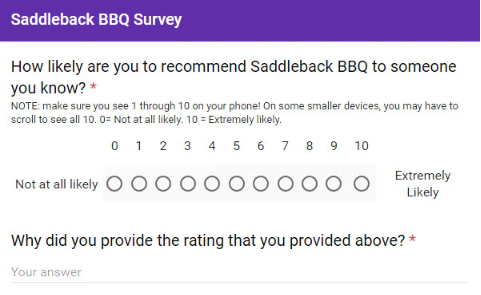Ever wondered how you can get your busy customers to give you a quick piece of feedback about your business? If you struggle to get customers to fill in longer customer feedback surveys, a quick NPS survey could be the answer.
Customer experience continues to grow in importance in all business industries. In fact, it’s the top priority for 45.9% of businesses for the next 5 years. With good reason too, since 86% of buyers are more willing to pay more for a great customer experience.
Understanding how your customers feel about your business will help you give them a better experience and ultimately grow your business.
So let’s take a look at how to create effective NPS surveys, use them in different industries, and how to implement their insights.
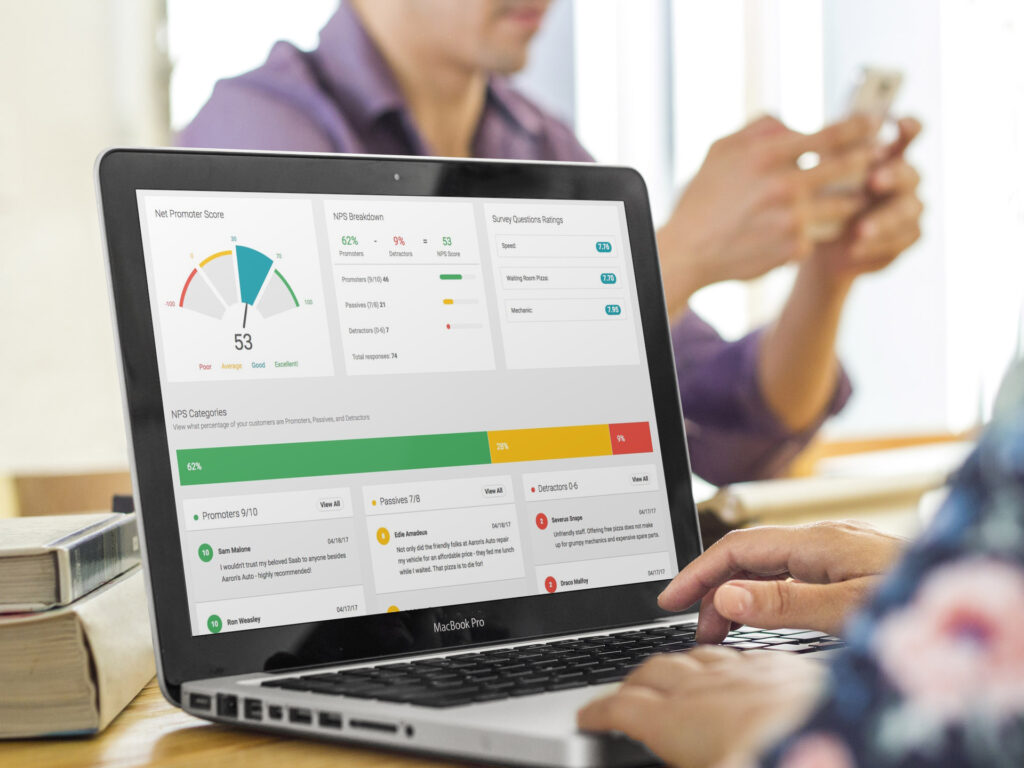
What Is a Net Promoter Score Survey (NPS)?
Net Promoter Score or NPS is a customer satisfaction metric that businesses can use to measure customer loyalty. NPS surveys ask customers how likely they are on a scale of 0-10 to recommend a business’s product or service to others.

Each score is allocated to one of three categories:
- Promoters are those who respond with a rating of 9 or 10.
- Passives are customers who respond with a rating of 7 or 8.
- Detractors are those who respond with a rating of 0-6.

To calculate your NPS score, minus the percentage of detractors from the percentage of promoters. Passives don’t impact your NPS score.
Here’s a visual of the NPS formula:
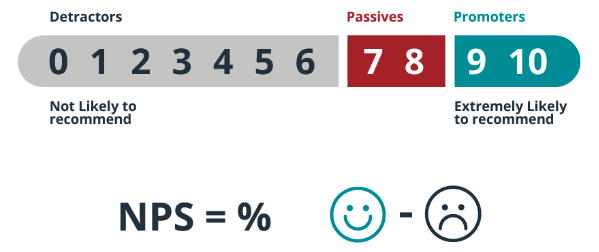
Once you calculate your NPS score, you should compare it to some basic NPS score ranges to get an idea of how your business is doing:
- -100 – 0: Poor and needs improvement
- 1 – 30: Average
- 31 – 70: Good
- 71 – 100: Excellent
Remember that it’s impossible to score a perfect 100 and that NPS scores vary widely by industry. We’ll be looking at industry benchmarks later in the article.
Put simply, Net Promoter Scores subtract the percentage of disappointed customers from the percentage of your enthusiastic satisfied customers.
To learn more about the metric and how to interpret it, check out our guide to NPS.
How Do You Create an NPS Survey?
Before you begin creating your NPS survey, it’s important to define your goal. Do you want to analyze customer experience throughout the purchase process? Do you want feedback about a new service?
Once you identify what you’re trying to achieve with your NPS survey, build an effective survey by following our step-by-step guide.
Step-by-Step Guide to Building an Effective NPS Survey
1. Include a mix of quantitative and qualitative questions
Since they ask customers to provide their answer as a rating on a scale, NPS survey questions are generally quantitative.
Here are some examples of quantitative NPS survey questions:
- Now that you’ve visited our new branch of [business name] how likely are you to recommend us to a friend or colleague?
- On a scale of 0-10, how likely is it that you would recommend [business name] to a friend or colleague?
Here’s an example of an NPS survey question from a taco restaurant followed by some more specific closed-ended questions:
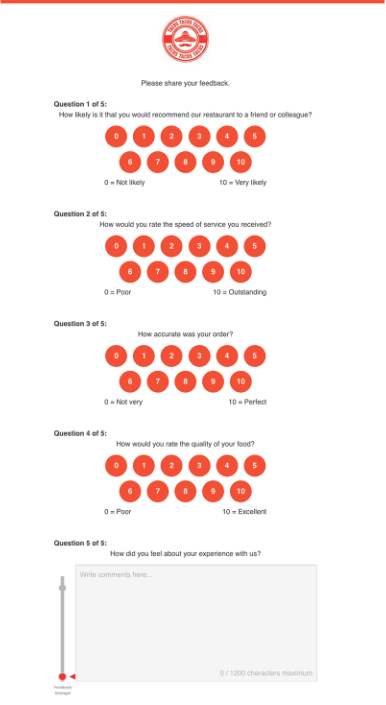
Qualitative questions should follow quantitative questions as a way of gaining more insights into customers’ opinions.
Here are some examples of quantitative questions:
- What’s one thing we could improve?
- Which service do you like the most?
2. Ask specific questions about your products/services
Making your NPS survey questions as specific as possible will help you gain more valuable insights.
Try to focus your NPS survey on specific elements of your business. You may want to request specific feedback on new products or new franchise locations for example.
Tailoring your questions to these elements of your business will make it easier to uncover specific parts of your business that require improvements.
Check out our post on how to create an effective customer satisfaction survey.
3. Get feedback at all parts of the customer journey
NPS surveys are best conducted when you use them at different moments throughout the customer journey.
You could send an NPS survey like this one following a visit to your restaurant:

For instance, if you run a subscription business like a gym, you may want to check in with your customers a month after they sign up for membership to see if they’re satisfied with the service.
You might then schedule another NPS survey 6 months later to see if they’d be likely to recommend your gym to their friends and colleagues as well as ask if there are any specific improvements they’d like to see.
4. Use GatherUp’s detailed NPS reporting feature to collect insights
NPS surveys are most valuable when you gather data and can effectively analyze it using powerful reporting tools.
To properly implement any customer feedback and take effective action, you’ll need to use detailed reporting creatures and functions. That way, once you’ve analyzed all responses you can build an actionable plan to put customer feedback into practice.
With GatherUp, you can compare up to 6 elements simultaneously. For instance, if you own a restaurant franchise, you could compare NPS scores by franchise location and identify which locations are performing better than others.
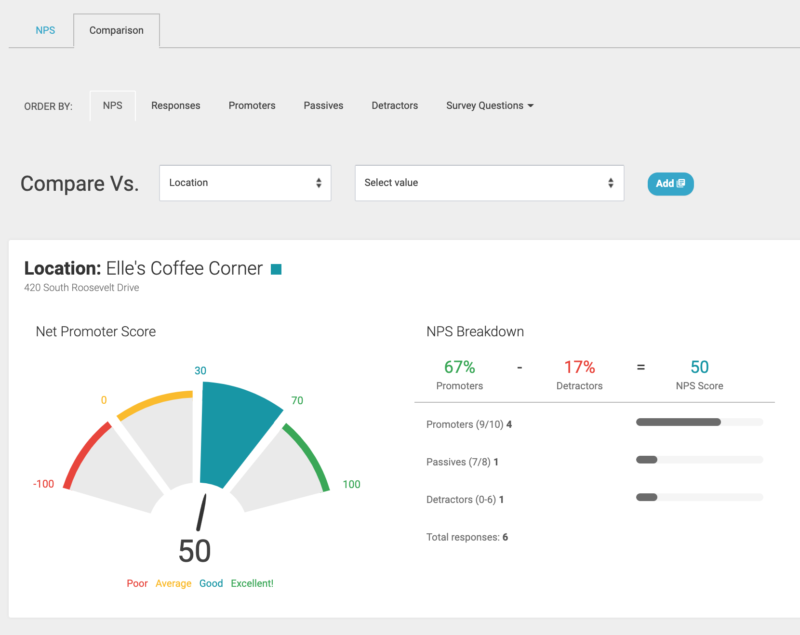
You could also order your NPS results by top NPS scores, the number of responses, and the number of promoters.
It’s easy to save these elements as a reporting template that you could access at a later date.
For more details on GatherUp, NPS reporting, check out our guide to using reporting features.
NPS Survey Best Practices
NPS surveys are most effective when you follow a few best practices. Here are some ways to get the most out of your NPS surveys.
1. Train your employees to properly ask customers for feedback
To ensure brand consistency across the board, all team members should know how to ask customers for feedback and why their approach is important. Employees need to know the best moments to approach customers and understand how to ask them for feedback.
Learn how to approach customers and train team members to ask for feedback in our blog post, how to ask for customer feedback.
2. Collect enough data so that it’s viable
To make your survey statistically valid, you need to collect sufficient responses from your customers. For instance, if you only have 10 responses but have a customer base of 5,000 it could be more challenging to draw any significant conclusions about your business’s customer experience.
To obtain the maximum number of responses, send out your NPS surveys at the right moment, place, and frequency for your customer base. Try sending out your NPS surveys on different days of the week and at different times to see what gains the most responses.
3. Multi-location businesses should be consistent
To get the most accurate responses from a good cross-section of customers, make sure you’re consistent with how and where you’re asking for NPS survey responses. Think about where you’re placing the survey and ensure that it’s the same across your business.
For instance, if one of your city center grocery stores sends NPS surveys out to customers by email, your beachside location should do too.
Remember to consider all the different methods you can use to get your NPS surveys in front of your customers. You could try:
- Paper questionnaires
- Email following a delivery or product purchase
- Text messages
- Signage using TextBack
Take a look at this example of using TextBack with a flyer in a restaurant:
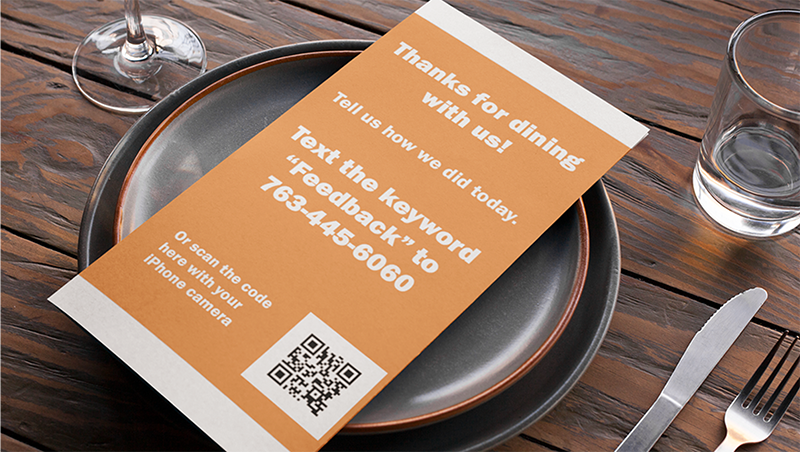
Depending on their preferences, you may find some methods work better than others. For instance, those waiting for doctor’s or lawyer’s appointments may be more receptive to paper questionnaires.
Text messages and signage may be better suited to restaurant businesses. We’ll look at more examples of how to best use NPS depending on your industry type later in this article.
How Often Should You Use NPS Surveys With Your Customers?
NPS surveys are a long-term measure of customer loyalty to your business so it’s best not to send out surveys too often. It’s important to strike the right balance between surveying your customers regularly and allowing them time to experience your business.
Create a Regular NPS Survey Schedule
Once you’ve sent out your first NPS survey, it’s important to send out follow-up surveys so you can monitor changes in your NPS scores over time.
After sending an initial NPS survey like this one, you could follow up 6 months later to track any changes in responses:
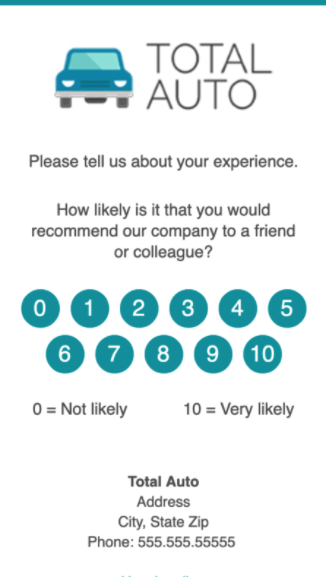
Send follow-up NPS surveys controlling for events like new location openings and new service launches which can create bias in your score.
NPS measures long-term customer loyalty, so it’s best to pick one or two dates every year to gather NPS scores.
Businesses with larger customer bases could send out NPS surveys monthly, but make sure you don’t ask the same customer base for their rating more than every 6 months.
Don’t Survey More Than You Can Respond
A great general guide to how often you should survey your customers is only as often as you’re able to reply to your customers, process feedback, and build an action plan to make improvements.
Frequent NPS surveys are of no use if you don’t have enough time to effectively analyze customer responses, understand what’s going on with your business’s customer experience, and create an improvement plan.
Consider the Buyer’s Journey
While some businesses may opt to schedule NPS surveys throughout the year, the optimum send-out moment will depend on your business model and industry.
If you plan to send out an NPS survey to your customers every 6 months, consider how it will look at each stage of the buyer’s journey, as it may not make sense for all business models.
For example, if you own a hotel, you could consider sending out an NPS survey following a reservation to check customer satisfaction with the booking process. Then within 48 hours of a guest’s stay, you could send another NPS survey monitoring satisfaction with the overall stay.
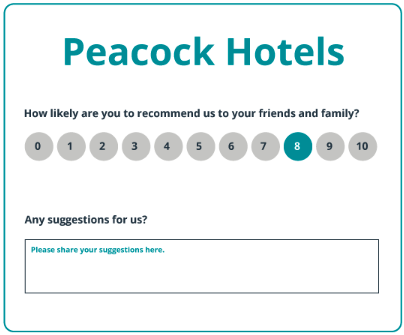
We’ll review more industry examples and how to best use NPS later in the article.
How Do You Take the Insights of an NPS Survey and Implement Them in Your Business?
Now you’ve gone to the effort of gathering and analyzing your NPS survey data, it’s time to implement the customer feedback into your business and build an improvement plan.
Compare Your NPS Score to the Industry Average
NPS is most helpful when compared to other businesses in your industry.
Different industry types see naturally higher or lower NPS results, based on factors outside your business’s direct control.
For instance, fast-food franchises have an average NPS score of 31 according to Delighted. Initially, if your fast food restaurant scored 35, you may think it’s a low score. But when compared to the industry average, you’ll see that it’s a few points higher.
The same goes for auto insurance businesses. According to NICE Satmetrix, businesses in auto insurance have an average score of 39 which could be considered low in other industries.
Knowing the industry average can help you set realistic customer satisfaction goals for your business.
If your score is low compared to your competitors and the rest of the industry, you know that you have work to do. If your NPS score is on the higher end of the scale, you can direct resources to ensure your business continues to perform well.
There’s Always Room For Improvement
A high NPS score isn’t a reason to stop improving your customer experience.
While a perfect NPS score of 100 may be virtually impossible, even if your business has a higher NPS score than the industry average, there’s always room to improve your customer experience.
If you own a multi-location business, learn from your top-performing locations. If you have several locations, you’ll probably notice some outliers that have much higher scores than others.
Identify what they’re doing differently – perhaps they put a lot of emphasis on efficient and friendly customer service.
Go Beyond Numbers for Deeper Insights
While NPS scores are great for giving you an indication of how loyal and enthusiastic customers feel, survey scores are most useful when they’re combined with follow-up questions.
While it’s always a good idea to include a few qualitative questions like ‘what is the main reason for your score?’ or ‘what did we do well, you should also follow-up with respondents who leave either exceptionally high or low NPS scores.
Both detractors and promoters will most likely have valuable insights to share about your business.
Multi-Location Businesses Should Create an NPS Floor
If you have a franchise business, implement an NPS floor that acts as a minimum standard for your multiple locations. An NPS floor would essentially indicate that a location is dropping below your business’s required standards. If a location falls below that NPS floor, put your resources and efforts into resolving the problem before it escalates.
These resources could include:
- Employee training sessions
- Monthly checks on the location
- Accessible guides that outline brand policies
Learn more about improving customer experience with feedback in our blog post on reputation management for franchises.
Pay Close Attention to the Promoters of Your Business
Sometimes it makes sense to pay more attention to the feedback of your promoters. This enables you to hone in on the elements of your business that keep your most valuable customers returning.
By focusing on your most enthusiastic customers, you’re also concentrating on another major area for potential growth, loyal customers who not only come back but who recommend your business to their friends.
Simply put, you should keep doing more of what encourages your promoters to choose your brand.
How to Use NPS Depending on Your Industry Type
The best moment to send an NPS survey depends on your industry type, business model, and customers. Remember that you can send NPS surveys at different times during the customer journey.
If you have larger customer segments, you may choose to send out an NPS survey once a month to different segments. Remember not to overdo it though and avoid asking customers for feedback more than once every 6 months.
Here are some industry examples of how and when to use NPS surveys based on your industry:
- Real Estate – For buyers, following the completion of a deal or once a search is called off is the best moment to send an NPS survey. Similarly, buyers should receive an NPS request following a successful sale or when the process is halted.

- Law Firms – Lawyers could ask regular clients to complete NPS surveys regularly throughout the year (every 6 months). You could also ask clients to fill out a quick NPS survey when they sign up for your services.
- Doctors and Dentists – Patients may have time to kill while they’re in waiting rooms and might be receptive to filling in paper NPS surveys that ask about the booking process and waiting room. You also should check in with patients following an appointment to evaluate if they’d recommend your business to friends and colleagues. If you have regular patients, you could send out a yearly or twice yearly NPS survey. If your doctor’s or dentist’s office is part of a larger multi-location business, an allocated team member in charge of customer satisfaction should compare NPS scores between different locations.
- Home Services (Plumbers, HVAC, landscapers) – Since customers tend to use home service businesses more randomly (eg. when their shower drain blocks or their boiler breaks) it’s best to send out an NPS survey within 48 hours of completed service to monitor customer satisfaction with the service.
- Salons – Salons that deal with more walk-in customers could send out a quick NPS survey following treatment to see if clients would recommend the service to friends and if they’re likely to return. For established salons that have a more long-term customer base, a once or twice yearly NPS survey would provide useful insights into overall satisfaction.
- Insurance Agencies – Brokers should send NPS surveys once a client has made a claim. Results from these NPS surveys will provide you with an insight into if your clients’ insurance needs are being met.
- Restaurants – Customers are most likely to be most receptive to an NPS survey right after a meal in your restaurant. You could experiment with customer segmentation to work out who are your most loyal repeat customers and send them an NPS survey once or twice a year too.
Final Thoughts
Conducting regular NPS surveys will help you evaluate how your business is doing when it comes to customer experience. Knowing who your promoters and detractors are will help you better direct your resources to the right places and improve your business.
Although NPS is a vital benchmark for understanding customer satisfaction, its real value lies in the follow-up and qualitative questions that you can use to uncover more specific details about your business’s offering. Ultimately, customer satisfaction and a solid group of promoters who talk about your business enthusiastically are key to maintaining loyal customers and gaining new ones.
Related reading:
